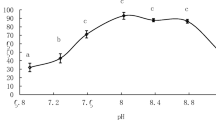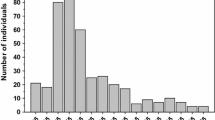Abstract
Acidification of rain water caused by air pollutants is now recognized as a serious threat to aquatic ecosystems. We examined the effects of low pH (control pH 7.5, pH 6, pH 5, pH 4) on the survival, growth, and shell quality of Macrobrachium rosenbergii postlarvae and early juveniles in the laboratory. Hatcheryproduced postlarvae (PL 5) were stocked at 250 PL per aquarium, acclimated over 7 d to experimental pH adjusted with hydrochloric acid, and reared for 30 d. Dead specimens were removed and counted twice a day. After 27 d rearing, all specimens were measured for total length and body weight. Carapace quality was assessed by spectrophotometry. Survival of juveniles was highest at pH 6 (binomial 95% confidence interval 79 - 89%) followed by control pH 7.5 (56 - 68%) and pH 5 (50 - 60%) and was lowest for unmetamorphosed postlarvae and juveniles at pH 4 (43 - 49%). The final median total length and body weight of juveniles were similar at control pH 7.5 (18.2 TL, 50.2 mg BW) and pH 6 (17.7 mm TL, 45.0 mg BW) but significantly less at pH 5 (16.7 mm TL, 38.2 mg BW); at pH 4, the postlarvae did not metamorphose and measured only 9.8 mm TL, 29.3 mg BW. Length frequency distribution showed homogeneous growth at pH 6, positive skew at control pH 7.5 and pH 5, and extreme heterogeneity at pH 4. The carapace showed different transmittance spectra and lower total transmittance (i.e. thicker carapace) in juveniles at pH 7.5, pH 6, and pH 5 than in unmetamorphosed postlarvae and juveniles with thinner carapace at pH 4. Thus, survival, growth, size distribution, and carapace quality of M. rosenbergii postlarvae and early juveniles were negatively affected by pH 5 and especially pH 4. The thinner carapace of the survivors at pH 4 was mostly due to their small size and failure to metamorphose. Natural waters affected by acid rain could decimate M. rosenbergii populations in the wild.
Similar content being viewed by others
References
Almut G, Bamber S (2013) Behavioural responses of Crangon crangon (Crustacea, Decapoda) to reduced Seawater pH following simulated leakage from sub-sea geological storage. J Environ Prot 4:61–67
Alston DE, Sampaio CMS (2000) Nursery systems and management. In: New MB, Valenti WC (eds) Freshwater prawn culture: the farming of Macrobrachium rosenbergii. Blackwell Science, Oxford, pp 112–156
Anonymous (2011) Vietnam-Netherlands Mekong Delta Masterplan Project: Mekong Delta Water Resources Assessment Studies. Southern Institute for Water Resources Planning, Ho Chi Minh, Vietnam, 67 p
Boßelmann F, Romano P, Fabritius H, Raabe D, Epple M (2007) The composition of the exoskeleton of two crustacea: the american lobster Homarus americanus and the edible crab Cancer pagurus. Thermochim Acta 463:65–68
Boeuf G, Payan P (2001) How should salinity influence fish growth? Comp Biochem Phys C 130:411–423
Boyd C, Zimmerman S (2000) Grow-out systems-water quality and soil management. In: New MB, Valenti WC (eds) Freshwater prawn culture: the farming of Macrobrachium rosenbergii. Blackwell Science, Oxford, pp 221–238
Chen SM, Chen J (2003) Effects of pH on survival, growth, molting and feeding of giant freshwater prawn Macrobrachium rosenbergii. Aquaculture 218:613–623
Chen JC, Kou CT (1996) Nitrogenous excretion in Macrobrachium rosenbergii at different pH levels. Aquaculture 144:155–164
Cheng W, Chen JC (1998) Enterococcus-like infections in Macrobrachium rosenbergii are exacerbated by high pH and temperature but reduced by low salinity. Dis Aquat Organ 34:103–108
Clopper C, Pearson ES (1934) The use of confidence or fiducial limits illustrated in the case of the binomial. Biometrika 26:404–413
Dall W (1965) Studies on the physiology of a shrimp, Metapenaeus sp. (Crustacea: Decapoda: Penaeidae). V. Calcium metabolism. Aust J Mar Freshw Res 15:145–161
Gandaseca S, Rosli N, Ngayop J, Arianto CI (2011) Status of water quality based on the physico-chemical assessment on river water at Wildlife Sanctuary Sibuti Mangrove Forest, Miri Sarawak. Am J Environ Sci 7:269–275
Gasim MB, Ismail BS, Torioman ME, Rahim SA, Islam MS, Chek TC (2006) Hydrology and water quality and land-use assessment of the Tasik Chini's feeder rivers, Pahang, Malaysia. Geografia 3:1–16
Haines TA (1981) Acidic precipitation and its consequences for aquatic ecosystems: a review. Trans Am Fish Soc 110:669–707
Hecht T, Pienaar AG (1993) A review of cannibalism and its implications in fish larviculture. J World Aquacult Soc 24:246–261
Ismael D, Nerw MB (2000) Biology. In: New MB, Valenti WC (eds) Freshwater prawn culture: the farming of Macrobrachium rosenbergii. Blackwell Science, Oxford, pp 18–40
Juahir H, Zain SM, Khan RA, Yusoff MK, Mokhtar MB, Toriman ME (2009) Using chemometrics in assessing Langat River water quality and designing a cost-effective water sampling strategy. Maejo Int J Sci Tech 3:26–42
Karplus I, Malecha SP, Sagi A (2000) The biology and management of size variation. In: New MB, Valenti WC (eds) Freshwater prawn culture: the farming of Macrobrachium rosenbergii. Blackwell Science, Oxford, pp 157–176
Kawamura G, Kian YAS, Chen CY, Lim LS (2014) Allometric identification of postlarvae and juveniles in freshwater giant prawn Macrobrachium rosenbergii (De Man). Aquacult Res (submitted)
Kurihara H, Ishiashi A (2008) Effects of high CO2 seawater on the copepod (Acartia tsuensis) through all life stages and subsequent generations. Mar Pollut Bull 56:1086–1090
Lemonnier H, Bernard E, Boglio E, Goarant C, Cochard J-C (2004) Influence of sediment characteristics on shrimp physiology: pH as principal effect. Aquaculture 240:297–312
Ling SW (1962) Studies on the rearing of larvae and juveniles and culturing of adults of Macrobrachium rosenbergii (de Man). 10th Session Indo-Pacific Fisheries Council, Technical Paper 57, 15 p
Madin K (2010) Ocean acidification: a risky shell game. Oceanus 48:6–7
Nair KKC, Branislav M, Rosenthal H, Jayalakshmi KV, Nost J (1999) Experimental studies on the cannibalistic habit of Macrobrachium rosenbergii (de Man). In: The Fourth Indian Fisheries Forum, Cochin, 24–28 November 1996, pp 227–232
National Research Council (1996) Guide for the care and use of laboratory animals. Institute of Laboratory Animal Resources, National Academy Press, Washington DC, 124 p
New MB (1995) Status of freshwater prawn farming: a review. Aquacult Res 26:l–54
New MB (2002) Farming Freshwater Prawns: a manual for the culture of the giant river prawn (Macrobrachium rosenbergii). FAO Fisheries Technical Paper No. 428, Food and Agriculture Organization, Rome, 212 p
Norela S, Nurfatihah MZ, Maimon A, Ismail BS (2009) Wet deposition in the residential area of the Nilai Industrial Park in Negeri Sembilan, Malaysia. World Appl Sci J 7:170–179
Pan LQ, Jiang LX, Miao JJ (2005) Effects of salinity and pH on immune parameters of the white shrimp Litopenaeus vannamei. J Shellfish Res 24:1223–1227
Preto BJ, Kimpara JM, Moraes-Valenti P, Valenti WC (2010) Population structure of pond-raised Macrobrachium amazonicum with different stocking and harvesting strategies. Aquaculture 307:206–211
Ranjeet K, Kurup BM (2002) Heterogeneous individual growth of Macrobrachium rosenbergii male morphotypes. Naga ICLARM Quart 25:13–18
Ravi R, Manisseri MK (2013) The effect of different pH and photoperiod regimens on the survival rate and developmental period of the larvae of Portunus pelagicus (Decapoda, Brachyura, Portunidae). Iran J Fish Sci 12:490–499
Segal E (1975) Growth and behavior of post juvenile Macrobrachium rosenbergii (de Man) in close confinement. Proc Ann Meet World Maricult Soc 6:67–88
Shuhaimi-Othman M, Ahmad A, Mushrifah I, Lim EC (2008) Seasonal influence on water quality and heavy metals concentration in Tasik Chini, Peninsular Malaysia. In: Sengupta M, Dalwani R (eds) Proceedings of Taal 2007: The 12th World Lake Conference, Anamaya Publishers, New Delhi, pp 300–303
Siegel S, Castellan NJ (1988) Nonparametric Statistics for the Behavioral Sciences, 2nd ed. McGraw-Hill Books, New York, 399 p
Snedecor GW, Cochran WG (1989) Statistical Methods, 8th ed. Iowa State University Press, Ames, 503 p
Song YL, Huang CC (1999) Application of immunostimulants to prevent shrimp diseases. In: Fingerman M, Nagabhushanam R (eds) Immunobiology and pathology: recent advances in marine biotechnology, vol. 5. Science Publishers, Enfield, New Hampshire, pp 173–188
Soper DS (2014) Binomial probability confidence interval calculator. http://www.danielsoper.com/statcalc
Spicer JL, Raffo A, Widdicombe S (2007) Influence of CO2-related seawater acidification on extracellular acid-base balance in the velvet swimming crab Necora puber. Mar Biol 151:1117–1125
Sumari SM, Darus MD, Kantasamy N, Taib NI, Sinyaw SU, Othman IR (2009) Composition of rainwater and aerosols at global atmospheric watch in Danum Valley, Sabah. Malaysian J Anal Sci 13:107–119
Tucker CS, D'Abramo LR (2008) Managing high pH in freshwater ponds. SRAC Publication No. 4604. South Regional Aquaculture Center, Stoneville, USA, 5 p
Wang SH, Chen JC (2005) The protective effect of chitin and chitosan against Vibrio alginolyticus in white shrimp Litopenaeus vannamei. Fish Shellfish Immun 19:191–204
Wilder MN, Yang WJ, Huong DTT, Maeda M (1999) Reproductive mechanisms in the giant freshwater prawn, Macrobrachium rosenbergii and cooperative research to improve seed production technology in the Mekong Delta region of Vietnam, In: Tamaru CC, Tamaru CS, Mvey LP, Ikuta K (eds) United States-Japan Natural Resources (UJNR) Technical Report No 28, University of Hawaii, Manoa, pp 149–156
Yeh SP, Liu CH, Sung TG, Lee PP, Cheng W (2006) Effect of saponin on hematological and immunological parameters of the giant freshwater prawn, Macrobrachium rosenbergii. Aquaculture 261:1432–1439
Author information
Authors and Affiliations
Corresponding author
Rights and permissions
About this article
Cite this article
Kawamura, G., Bagarinao, T., Yong, A.S.K. et al. Low pH affects survival, growth, size distribution, and carapace quality of the postlarvae and early juveniles of the freshwater prawn Macrobrachium rosenbergii de Man. Ocean Sci. J. 50, 371–379 (2015). https://doi.org/10.1007/s12601-015-0034-0
Received:
Revised:
Accepted:
Published:
Issue Date:
DOI: https://doi.org/10.1007/s12601-015-0034-0




